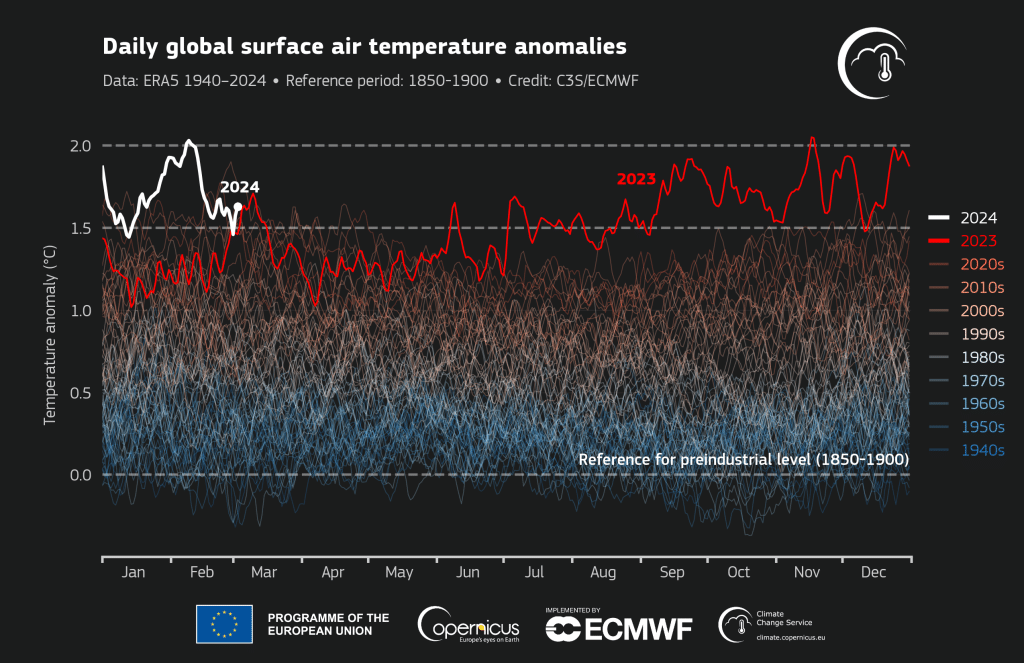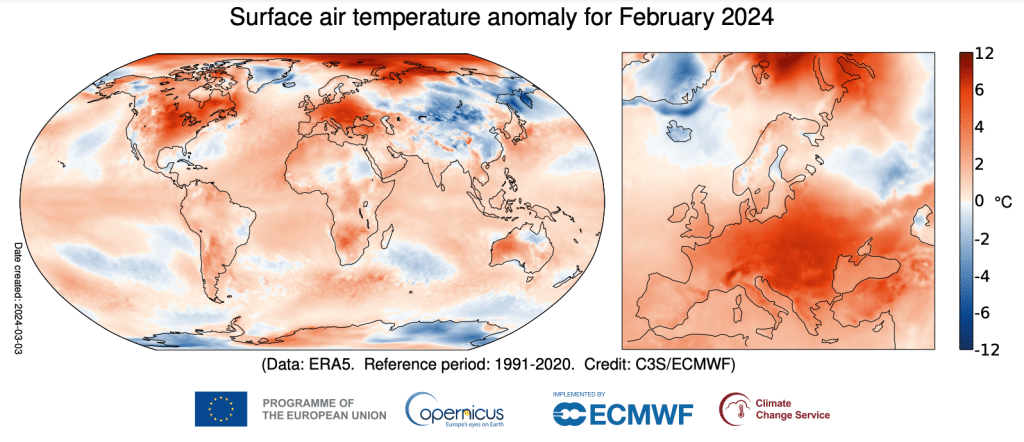Average surface temperatures in February were 0.81C higher than the 1991-2020 average. and 1.77C above pre-industrial levels.
—
With an average temperature of 13.54C, February 2024 was the hottest February ever recorded globally, breaking the previous record set in 2016 by 0.12C, the Copernicus Climate Change Service (C3S) has announced.
Daily global average temperature records were broken for four consecutive days last month, reaching 2C above the 1850-1900 levels.
With temperatures at 1.77C above an estimate of the February average for 1850-1900, last month also marked the ninth consecutive time that recorded temperatures for a particular month have reached unprecedented levels.

Most regions around the world, including northern Siberia, central and northwest North America, most of South America, Africa, and western Australia, saw above-average temperatures, though Europe bore the most brunt, with temperatures in February at 3.30C above the 1991-2020 average for that month, the European Union’s Earth Observation program said in a press release on Tuesday.

Sea temperatures also remained at an “unusually high level,” continuing a long trend of “persistently and unusually high” sea temperatures since May of last year.
Earlier this week, experts warned of a potential fourth mass coral bleaching event linked to marine heatwaves. Within the last century, sea temperatures have risen at an average rate of 0.13C every decade. Warmer waters make coral reefs more vulnerable to bleaching outside of summer seasons while impeding their ability to naturally recover.
Unfolding Trend
2023 was the hottest year on record, supercharged by the return of the El Niño, a weather phenomenon that has pushed temperatures off the charts around the world and that is expected to last well into 2024.
Last month, Copernicus confirmed that the critical 1.5C global warming threshold set in the Paris Agreement was breached over a twelve-month period for the first time in history, with global temperatures at 1.52C above the 19th century benchmark. While this does not signal a permanent breach of the limit, which scientists say is measured over decades, it sends a clear warning to humanity that we are approaching the point of no return much faster than expected.
According to the United Nations, the world is on track to warm well above 2C and we are running out of time to make the transformational changes required to cap global temperature rises.
Commenting on the latest findings, Carlo Buentempo, Director of C3S, said February’s record-breaking temperatures were “not really surprising.”
“The climate responds to the actual concentrations of greenhouse gases in the atmosphere so, unless we manage to stabilise those, we will inevitably face new global temperature records and their consequences,” Buentempo said.
According to the latest analysis on global carbon dioxide (CO2) levels by the International Energy Agency (IEA), global CO2 emissions grew by 410 million tonnes – or 1.1% – in 2023, reaching a historic high of 37.4 billion tonnes. This was partly due to a global shortfall in hydroelectric power generation linked to historic droughts that have affected many regions of the world, which drove up emissions from fossil fuels by an additional 170 million tonnes. Without it, the agency said, global emissions would have likely declined last year.
You might also like: Extreme Weather Events Cause $200bn in Economic Losses Globally, Philippines and US Hit the Hardest, Report Finds
Featured image: fosco lucarelli/Flickr


















